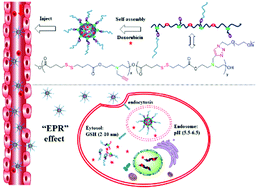Chemoenzymatic synthesis of dual-responsive graft copolymers for drug delivery: long-term stability, high loading and cell selectivity†
Abstract
A series of amphiphilic graft copolymers, poly(N-propargyldiethanolamine 4,4′-dithiodibutyionate)-graft-monomethoxy poly(ethylene glycol) (PPD-g-mPEG), were designed via a chemoenzymatic method for pH and reduced glutathione (GSH) dual-responsive drug delivery. The effects of percent grafting and molecular weights of mPEG on critical micelle concentration (CMC) values, size of micelles, drug loading and dual-response were tested. The graft copolymers could easily form homogeneous spherical micelles with appropriate sizes and zeta-potentials. The micelles of PPD-g-mPEG copolymers loaded doxorubicin (DOX) in high efficiency, and showed excellent stability under physiological conditions and synergetic dual-response to weakly acidic pH and GSH. In vitro experiments confirmed that the DOX-loaded micelles could be internalized into cancer cells efficiently and release DOX over time. Furthermore, cell cytotoxicity assays indicated that the graft copolymers were non-cytotoxic to both cancerous and normal cells while the DOX-loaded micelles greatly improved the selectivity ratios between HeLa cells and HL-7702 cells. DOX-loaded micelles also avoided hemolysis of red blood cells (RBCs) effectively compared with commercialized doxorubicin hydrochloride. All these demonstrated the potential of PPD-g-mPEG as a model to create more functional dual-responsive nanocarriers for controlled drug delivery.



 Please wait while we load your content...
Please wait while we load your content...